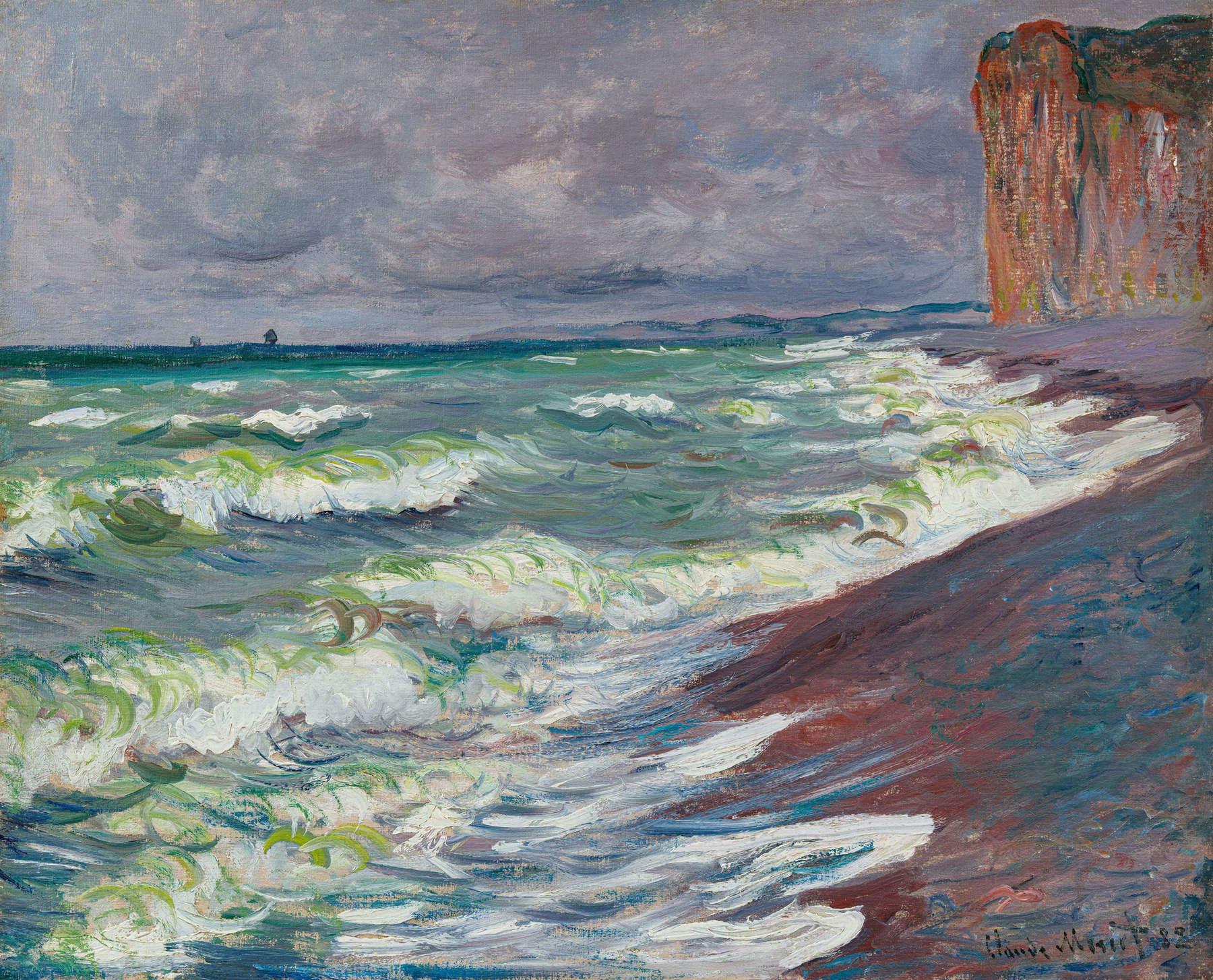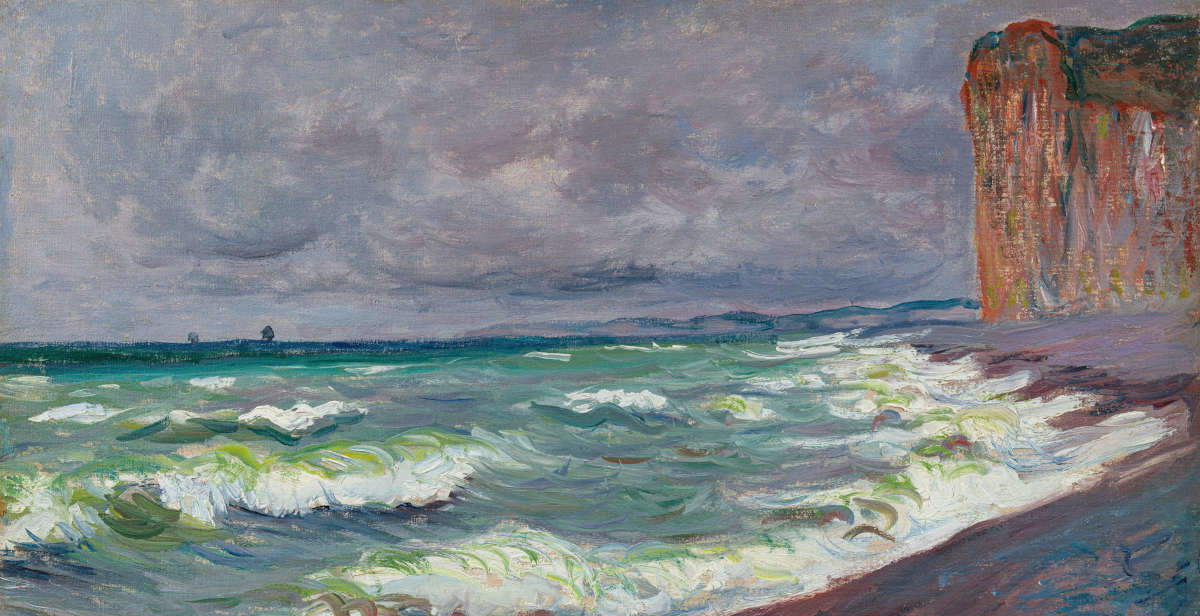A rare Claude Monet seascape goes up for auction: it is the only painting in winter
An important painting by Claude Monet (Paris, 1840 - Giverny, 1926), Mer agitée à Pourville, goes up for auction at Lempertz in Cologne on Nov. 29: executed in 1882, it is Monet’s only beach scene depicting the Normandy landscape during the winter season. Claude Monet’s paintings rarely appear on the German auction market: so this will be an important moment for the German market. The estimate is 3-4 million euros.
The artist visited his brother in the seaside resort of Petites-Dalles in 1880: it was a trip with far-reaching consequences for art history, as Monet would become fascinated by the rugged cliffs of Normandy. Encouraged by his patron Paul Durand-Ruel’s positive reaction to his early seascapes, Monet soon returned to the coast, in March 1881, this time to the fishing village of Fécamp. Particularly famous became his images of the coast here, where impressive white cliffs fall vertically into the sea. His enthusiasm for the subject peaked during a subsequent stay in the region around 1882. Monet stayed at a hotel near the small fishing village of Pourville, and there he explored the dynamics of the elements, for the first time even in winter. However, only one painting from this particularly stormy time of year has survived: it is indeed Mer agitée à Pourville.

The genesis of the painting
For the artist, who grew up in Le Havre, choosing Normandy as a place to work meant a return to his roots. It was precisely in Normandy that Monet redefined the genre of the navy, which he was already familiar with from his youth in Le Havre through the sea images of Eugène Boudin, an artist fundamental to the development of his painting. In Monet’s work, the atmospheres of light and shades of color found in the sky, water and reefs amidst the constantly changing weather and seasons are powerfully and directly realized. In 1927, journalist François Thiébault-Sisson recounted Monet’s efforts as he attempted to paint during a storm on the coast of Étretat: “After inquiring precisely about the height the waves could reach, he set up his easel inside a crevice in the steep cliffs of the coast at the height necessary to avoid being swept away by the water. As an added precaution, he anchored the easel with strong ropes and securely fastened the canvas to the easel. Then he began to paint. The sketch developed beautifully as drops of water fell on it from the sky. At the same time, the storm grew stronger. [...] Monet kept working like a maniac, paying no attention to anything. Suddenly a gigantic wave ripped him from the folding chair. It swept over him, completely submerged him, and threatened to drag him away with it when, obeying a sudden instinct, he let go of palette and brush and grabbed the rope holding the easel.”
In Pourville, Monet resided in a hotel near the beach. The images made here are seen in a very direct way: the extraordinary natural scenery that characterizes the hills to the east and west of the village, which drop vertically toward the sea, are depicted from different vantage points, with varying weather conditions and water levels. Mer agitée à Pourville, the only painting in the series to depict the stormy sea, places the viewer directly at the water’s edge, in the midst of the elements. Above the rough sea, the view extends far to the east, where the further course of the coast is vaguely glimpsed, with storm clouds gathering in the gray-violet sky above. The stony beach in the foreground is bathed in dark shades of blue and reddish brown. As a result, the foamy ridges shine even brighter on the turbulent water, depicted in numerous shades of blue, turquoise and green. Waves break in light green swirls and bright white foam; white elongated arcs of foam spill onto the shore. In the background rises vertically the rock face in warm earth tones. Only the tiny silhouettes of two ships on the horizon suggest the presence of people; the rest of the scene is a pure, unspoiled natural spectacle. In June of that year, Monet returned to Pourville with his family and created summer images of the coastal landscape.
Passages from the work
The spring of 1882 also had special significance for Monet because the " 7th Exhibition of Independent Artists," or the seventh exhibition of Impressionists, organized by Durand-Ruel, presented 35 works by Monet-along with those of Gustave Caillebotte, Paul Gauguin, Armand Guillaumin, Berthe Morisot, Camille Pissarro, Pierre-Auguste Renoir, Alfred Sisley and Victor Vignon. The exhibition opened on March 1 and was well received by critics and the public. Monet’s paintings of the Fécamp coast received special praise. “I pause before these marvelous pieces of sea,” wrote critic Ernest Chesneau, “which mark the first time that I feel such a powerful illusion of the swelling and long sighing of the sea, the flowing backwardbackward flow of the water as the flood recedes, the grayish-green tint of the water’s depths and the purplish tint of the shallow water above its bed of sand.”
Monet allegedly sold the painting to gallery owner Paul Durand-Ruel just a year after its completion. Durand-Ruel’s mediation played an important role in the development of Impressionism and was particularly important to Claude Monet’s career. Indeed, the art dealer was the Impressionists’ most important supporter and advocate and enjoyed the right of first refusal for Monet’s work because of his substantial financial support for the artist. In 1886 the dealer brought more than 300 Impressionist works to the United States, where they met with an enthusiastic response; in 1887 Durand-Ruel opened a permanent branch of his gallery on New York’s Fifth Avenue. Probably from there Mer agitée à Pourville entered the collection of businesswoman and collector Catholina Lambert (1834-1923). After emigrating to Boston from England as a young woman, Lambert worked in the silk industry and amassed a large fortune. She amassed the vast collection of art and antiques she had gathered over the years in her magnificent Belle Vista mansion in Paterson, New Jersey. The decline of the silk industry and a strike by its workers led to the bankruptcy of Lambert’s company in 1913, and as a result she was forced to auction off her collection, including Monet’s work. At the auction held at the Plaza Hotel in New York in February 1916, this painting was sold as lot 158 with the title “Marine.” The work went through other auctions: in 1957 and 2001, before reaching its current owner.
 |
| A rare Claude Monet seascape goes up for auction: it is the only painting in winter |
Warning: the translation into English of the original Italian article was created using automatic tools. We undertake to review all articles, but we do not guarantee the total absence of inaccuracies in the translation due to the program. You can find the original by clicking on the ITA button. If you find any mistake,please contact us.




























